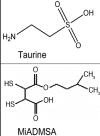Combined administration of taurine and monoisoamyl DMSA protects arsenic induced oxidative injury in rats
- PMID: 19794907
- PMCID: PMC2715192
- DOI: 10.4161/oxim.1.1.6481
Combined administration of taurine and monoisoamyl DMSA protects arsenic induced oxidative injury in rats
Abstract
Arsenic is a naturally occurring element that is ubiquitously present in the environment. High concentration of naturally occurring arsenic in drinking water is a major health problem in different parts of the world. Despite arsenic being a health hazard and a well documented carcinogen, no safe, effective and specific preventive or therapeutic measures are available. Among various recent strategies adopted, administration of an antioxidant has been reported to be the most effective. The present study was designed to evaluate the therapeutic efficacy of monoisoamyl dimercaptosuccinic acid (MiADMSA), administered either individually or in combination with taurine post chronic arsenic exposure in rats. Arsenic exposed male rats (25 ppm, sodium arsenite in drinking water for 24 weeks) were treated with taurine (100 mg/kg, i.p., once daily), monoisoamyl dimercaptosuccinic acid (MiADMSA) (50 mg/kg, oral, once daily) either individually or in combination for 5 consecutive days. Biochemical variables indicative of oxidative stress along-with arsenic concentration in blood, liver and kidney were measured. Arsenic exposure significantly reduced blood delta-aminolevulinic acid dehydratase (ALAD) activity, a key enzyme involved in the heme biosynthesis and enhanced zinc protoporphyrin (ZPP) level. Clinical hematological variables like white blood cells (WBC), mean cell hemoglobin (MCH), and mean cell hemoglobin concentration (MCHC) showed significant decrease with a significant elevation in platelet (PLT) count. These changes were accompanied by significant decrease in superoxide dismutase (SOD) activity and increased catalase activity. Arsenic exposure caused a significant decrease in hepatic and renal glutathione (GSH) level and an increase in oxidized glutathione (GSSG). These biochemical changes were correlated with an increased uptake of arsenic in blood, liver and kidney. Administration of taurine significantly reduced hepatic oxidative stress however co-administration of a higher dose of taurine (100 mg/kg) and MiADMSA provided more pronounced effects in improving the antioxidant status of liver and kidney and reducing body arsenic burden compared to the individual treatment of MiADMSA or taurine. The results suggest that in order to achieve better effects of chelation therapy, co-administration of taurine with MiADMSA might be preferred.
Keywords: arsenic toxicity; chelation; oxidative stress; taurine.
Figures



Similar articles
-
Response of arsenic-induced oxidative stress, DNA damage, and metal imbalance to combined administration of DMSA and monoisoamyl-DMSA during chronic arsenic poisoning in rats.Cell Biol Toxicol. 2007 Mar;23(2):91-104. doi: 10.1007/s10565-006-0135-8. Epub 2006 Nov 1. Cell Biol Toxicol. 2007. PMID: 17086449
-
Combined administration of iron and monoisoamyl-DMSA in the treatment of chronic arsenic intoxication in mice.Cell Biol Toxicol. 2007 Nov;23(6):429-43. doi: 10.1007/s10565-007-9005-2. Epub 2007 Apr 24. Cell Biol Toxicol. 2007. PMID: 17453351
-
Beneficial effect of combined administration of some naturally occurring antioxidants (vitamins) and thiol chelators in the treatment of chronic lead intoxication.Chem Biol Interact. 2003 Jun 15;145(3):267-80. doi: 10.1016/s0009-2797(03)00025-5. Chem Biol Interact. 2003. PMID: 12732454
-
Chemistry, Pharmacology, and Toxicology of Monoisoamyl Dimercaptosuccinic Acid: A Chelating Agent for Chronic Metal Poisoning.Chem Res Toxicol. 2022 Oct 17;35(10):1701-1719. doi: 10.1021/acs.chemrestox.2c00129. Epub 2022 Aug 16. Chem Res Toxicol. 2022. PMID: 35972774 Review.
-
Arsenic induced oxidative stress and the role of antioxidant supplementation during chelation: a review.J Environ Biol. 2007 Apr;28(2 Suppl):333-47. J Environ Biol. 2007. PMID: 17929749 Review.
Cited by
-
Arsenic responsive microRNAs in vivo and their potential involvement in arsenic-induced oxidative stress.Toxicol Appl Pharmacol. 2015 Mar 15;283(3):198-209. doi: 10.1016/j.taap.2015.01.014. Epub 2015 Jan 24. Toxicol Appl Pharmacol. 2015. PMID: 25625412 Free PMC article.
-
Ameliorative Potential of Psidium guajava on Hemato-biochemical Alterations in Arsenic-exposed Wistar Rats.Toxicol Int. 2012 May;19(2):121-4. doi: 10.4103/0971-6580.97199. Toxicol Int. 2012. PMID: 22778508 Free PMC article.
-
N-acetylcysteine and meso-2,3-dimercaptosuccinic acid alleviate oxidative stress and hepatic dysfunction induced by sodium arsenite in male rats.Drug Des Devel Ther. 2016 Oct 20;10:3425-3434. doi: 10.2147/DDDT.S115339. eCollection 2016. Drug Des Devel Ther. 2016. PMID: 27799742 Free PMC article.
-
Free Radical-Scavenging, Anti-Inflammatory/Anti-Fibrotic and Hepatoprotective Actions of Taurine and Silymarin against CCl4 Induced Rat Liver Damage.PLoS One. 2015 Dec 11;10(12):e0144509. doi: 10.1371/journal.pone.0144509. eCollection 2015. PLoS One. 2015. PMID: 26659465 Free PMC article.
-
The Protective Effects of Taurine, a Non-essential Amino Acid, Against Metals Toxicities: A Review Article.Biol Trace Elem Res. 2025 Feb;203(2):872-890. doi: 10.1007/s12011-024-04191-8. Epub 2024 May 13. Biol Trace Elem Res. 2025. PMID: 38735894 Review.
References
-
- World Health Organization (WHO), author Guidelines for Drinking Water Quality. second ed. WHO, Geneva; pp. 41–42. vol.
-
- Rahman MM, Chowdhury UK, Mukherjee SC, Mondal BK, Paul K, Lodh D, Biswas BK, Chanda CR, Basu GK, Saha KC, Roy S, Das R, Palit SK, Quamruzzamam Q, Chakraborty D. Chronic arsenic toxicity in Bangladesh and West Bengal, India—A review and commentary. J Toxicol Clin Toxicol. 2001;39:683–700. - PubMed
-
- Parvez F, Chen Y, Argos M, Iftikhar Hussain AZM, Momotaj H, Dhar R, Van Green A, Graziano JH, Ahsan H. Prevalence of arsenic exposure from drinking water and awareness of its health risks in a Bangladeshi population: results from a large population-based study. Environ Health Perspect. 2006;114:355–359. - PMC - PubMed
-
- Guha Mazumder DN. Effects of chronic intake of arsenic-contaminated water in liver. Toxicol Appl Pharmacol. 2005;206:169–175. - PubMed
-
- Flora SJS, Dube SN, Arora U, Kannan GM, Malhotra PR. Therapeutic potential of meso 2,3-dimercaptosuccinic acid or 2,3-dimercapto propane 1-sulphonate in chronic arsenic intoxication in rats. Biometals. 1995;8:111–116. - PubMed
Publication types
MeSH terms
Substances
LinkOut - more resources
Full Text Sources
Medical

